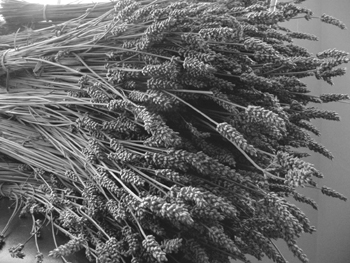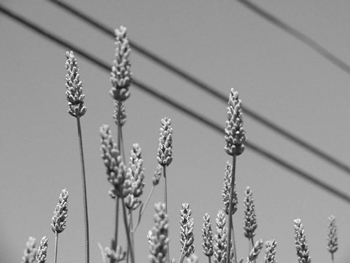![[Metroactive Features]](/features/gifs/feat468.gif)
[ Features Index | Santa Cruz Week | SantaCruz Home | Archives ]
Purple Haze
Santa Cruz is a hot spot for the cottage industry that's sprung up around lavender farming. The downside is that actually doing the farming is enough to drive you crazy.
By Sarah Phelan
It's 6am on a foggy Sunday in July, somewhere along the remote North Coast, and I'm sitting on an upturned bucket harvesting lavender. Despite the early hour, bursts of mariachi music waft from the neighboring Brussels sprout farm, a sure sign that their workers are taking a well-earned break inside the shacks they currently call home.
There will be no lie-ins for me today--or any time during the month-long lavender harvest. Little did I know what I was getting into when I moved here in January; all I'd have to do, said my landlady, was harvest 150 of the drought-resistant bushes, dry the stalks in bundles, then ship them to a warehouse, and bingo, I'd have offset my rent.
Six months later and I realize there's no money to be made, as I struggle to keep abreast of the purple waves, silent signals that thousands of stalks are ready to be hand-picked. Now.
And while that's not great financial news, I'm not freaking out.
Why? Because I've fallen under the sway of this aromatic herb. Once an epic late-riser, I now look forward to getting up at dawn and watching the fog burn off the fields, before I begin the daily search for almost budding flowers and woody stems, twin signs of harvest readiness.
"What existential difference is there between the human being's role in this (or any) garden and the bumblebee?" asks Michael Pollan in The Botany of Desire.
None, I think, as the bees and I bumble among swaying stands, intoxicated by the sweet grassy fragrance that fills the air each time we brush these purple-headed stems.
Later, as I sort stalks into bundles and my cat enjoys lavender-infused dreams, I figure that what I'm really getting out of all this is a massive dose of lavender therapy.
But later, as I hang another hundred bundles to dry in the dilapidated barn, which does the job perfectly thanks to the ocean breeze that blows through the chinks most afternoons, I wonder: to what effect? Lavender's calming properties are world renowned, but my obsession with it of late seems to be having the opposite effect: it's driving me crazy.
And I don't think I'm alone, since besides my own personal descent into lavender-driven madness, I've noticed all the experts that I've met in this cottage industry so far share one thing in common: an insatiable desire for lavender-based empire.
English Estate
Take Gary Meehan, the proprietor of Bonny Doon Farm.
"Lavender's time is over. Spanish oregano is the way to go," says Meehan, sounding a tad defensive, when I tell him that I tend a lavender farm, in between being a full-time reporter.
Meehan, who describes his operation as "America's first English lavender estate," later cops to having a bit of an attitude, at least when it comes to questions about his enterprise.
"I'm the child of the pool hall that once occupied 382 Pacific Ave. My father owned it. The pool hall was a little rough and tumble, so when people ask about my dear crop, I get a little defensive. One time, I had a guy show up who wouldn't leave. I had to call the sheriff. And we've had some really dumb inquiries, so I get really protective," Meehan tells me, when I ask if I can visit his estate--which, as the Bonny Doon Farm website states, is not open to the public.
In the end, I suspect it was my British accent which granted me access, because Meehan is a self-described Anglophile, as evidenced by the three gleaming Norton motorbikes that grace his garage--except on Sundays, when he rides them "along the byways, not the highways," that wind through the hills beyond his estate.
"Lavender is an amazing plant, but I don't encourage farming of it," says Meehan, who blames plummeting lavender prices on an influx of small farmers since 1972, which is when he and his wife Diane started their five-acre operation, adjacent to a 500-acre state reserve.
Some people battle with nature, others work with it, and the Meehans chose the latter path, beginning with the soil that covers their land.
"When we were trying to grow our first crop, we noticed the soil was sandy as hell, which was when my mother-in-law Frieda suggested, 'Why don't you dears try lavender,' which is why we're doing what we do--and why we named a lavender after her," says Meehan, who believes every garden should feature this sweet-smelling herb.
"Mint where the water drips, lavender where it's dry," is his advice.
"It's a delightful thing to be around, and my personal experience is that it's very effective on mosquito bites and burns. And very relaxing. When we decant the oil, we sleep better."
Five years after harvesting their first lavender crop, the Meehans got into making soap, starting out on their kitchen floor, then in a room in a barn next door, before moving the operation up the hill and into the home of Mary Jessen, who for the past 10 years has taken on the responsibility of hand-cutting Bonny Doon Farm's lavishly rich soaps.
"We make our soap by hand in small batches of twenty bars only, and always will," he says.
Total madness, when you think about it, especially when you consider that the Meehans have stuck to their guns about making "uncompromised" choices of top quality ingredients, including the finest cocoa butter, olive oil and essential oils, cost be damned.
What's even crazier is that the strategy has paid off. Despite the equally lunatic reality that Bonny Doon Farm has never had a sales rep and only sells to independently owned stores, its soaps and lotions grace 1,000 stores nationwide, including the Tea House Spa and Artisans in Santa Cruz, and Coast Ranch in Big Sur.
Of course, one data point does not prove an empire-building theory. So, how about the case of Elizabeth van Buren, who has parlayed her interest in lavender and other herbs into a thriving essential oil business and the burgeoning College of Botanical Healing Arts.
Van Buren blames her initial fascination with plants on her father, who loved gardening, but her passion grew more serious when her son developed bronchial problems.
"I got him off antibiotics by using herbs, at which point I realized the value of botanicals," says van Buren, who founded a business based on herbs and taught classes at local schools, until 1990, when she switched her focus to developing a line of 85 essential oils and opening her College of Botanical Healing Arts on 17th Avenue.
She notes that essential oil of lavender sells three time as much as other oils in her line, and is good for countering stress, anxiety and insomnia.
"Lavender balances the central nervous system and can be used as a natural Ritalin substitute for cats, dogs and hyperactive kids."
Like Meehan, van Buren recommends lavender for burns, as well as for painful joints and digestive, respiratory and cardiovascular problems.
"It can help women during PMS, childbirth and menopause. And it's a natural antibacterial and antifungal, a preventative medicine that has no side effects if used in the right dosages. It's also a natural insect repellent and disinfectant."
Lavender has also been a key ingredient in perfumery ever since 1560, when, in another classic example of empire building, Italian Catherine de Medici introduced it to Provence, whose purple fields soon became synonymous with the heart and soul of France's perfume industry.
So, is there anything not to like about this sweet-smelling herb?
"The prohibitive cost of producing high quality essential oil, locally," says van Buren, whose husband, Larry Jones, is an analytical chemist who helps her import essential oils from all over the world to bottle and create Elizabeth van Buren blends.
"It takes 50 plants to make one ounce of essential oil," says Jones, noting that the calm, sleepy feeling people get around lavender is "a biochemical reaction" to lavender's 60 different chemicals getting into the lungs or through the skin.
While the cost of lavender oil ranges from several thousand dollars to several bucks a pound, depending on the quality, amateur gardeners can get about a pound of oil from one mature bush to use in homemade lotions, scents and therapeutic potions.
Observing that England's Queen Elizabeth I encouraged households to create their own healing products, van Buren says, "since my first name is also Elizabeth, I want to encourage people to do that here."
Stills and Sorbets
As it happens, Susan Ditz and Fred Brittle, who run Rancho Alegre, a four-acre Pescadero-based lavender farm, are already marketing small home stills for precisely that purpose, as well as building a lavender empire involving everything from eye pillows and bath and body products to lavender-infused food and drink.
Several months ago, the couple purchased Floragenics, an online company that sells distilling systems, which break down botanicals like lavender into essential oils and floral water.
Engaging me in conversation about steam condensers, distilling columns and separatory funnels, Brittle, who's an archetypal handyman, reveals that his next step is to make a machine which harvests lavender by separating the flowers from the stalks.
All of which seems to prove that lavender can actually be hazardous to your mental health--if farmed. Because whether you're drying and distilling or making lotions and potions, lavender requires your full attention, and then some--which let's face it, is totally crazy-making.
And so, as I prepare to ship 552 dried bundles to a warehouse in Watsonville, I swear to get away from this stuff while I can, even as I tip my hat to all the lavender lunatics in the world, who help bring us this sweet-smelling medicine. All I wanted was the experience--and the stories. The empire-building, I'll leave to the experts.
Copyright © Metro Publishing Inc. Maintained by Boulevards New Media.
![]()

Photograph by Sarah Phelan

Botanical Healing
For information, contact:
www.bonnydoonfarm.com
www.cobha.org
www.ranchoalegre-lavender.com
From the July 30-August 6, 2003 issue of Metro Santa Cruz.